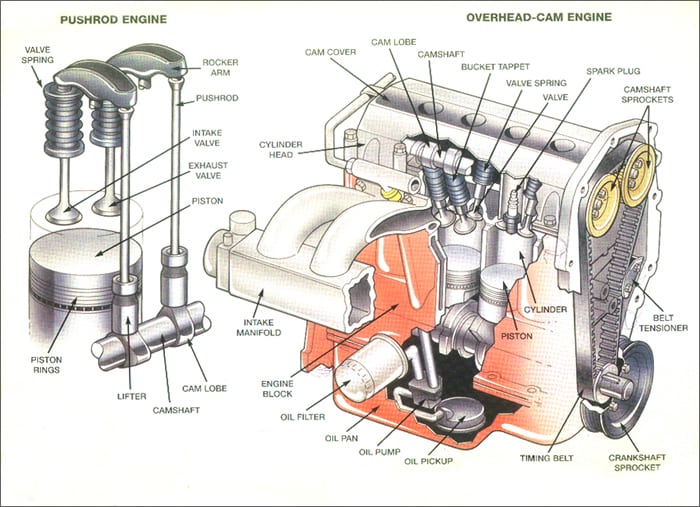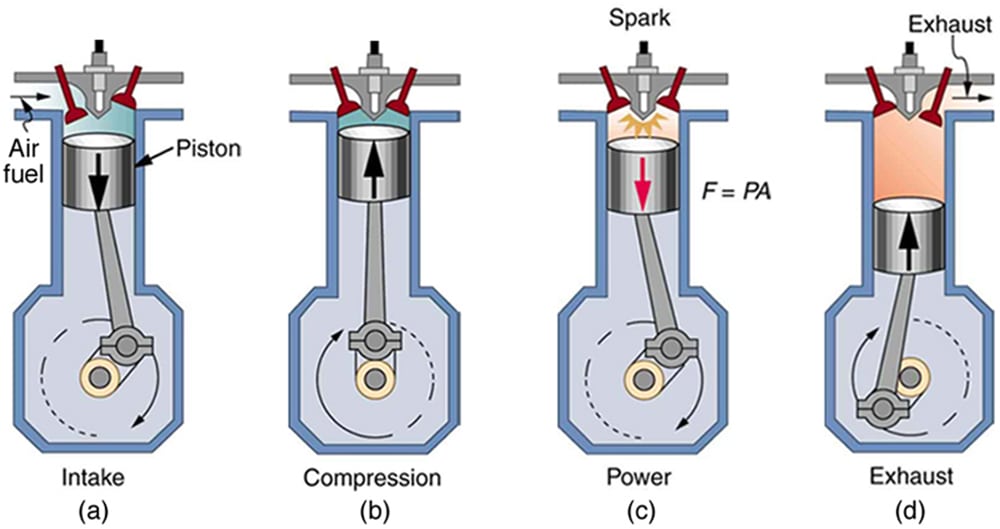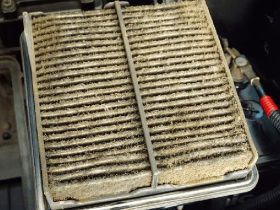Nearly all automotive engines work on one of two engine types: four-stroke gasoline or four-stroke diesel. Few other types of engine are still in use today, though there are variations on both the gasoline and diesel that we will discuss in future articles. Today, we’re going to talk about the basics of combustion engine technology and focus on the four-stroke gasoline engine used in the vast majority of automobiles in the U.S. We will follow up soon with a similar look at diesel engines. In addition, you may also be interested in finding out how an electric vehicle works.
The Four-Stroke Process
Most of today’s vehicles used what’s called a reciprocating combustion engine. The gasoline four-stroke is the most common of these. It has four basic “strokes” that produce the turning motion that drives the car forward.
1. Intake Stroke – Piston descends, pulling air into the cylinder through open intake valves, fuel is injected simultaneously.
2. Compression Stroke – Valves close, piston reverses, pushing upwards, compressing the fuel-air mixture into a dense “cloud” which will burn more quickly and thoroughly.
3. Power Stroke – A spark ignites the compressed mixture, creating combustion which expands the gases in the chamber, forcing the piston back down.
4. Exhaust Stroke – The piston returns upwards as the exhaust vents open, pushing the exhaust gases out of the cylinder.
When two or more cylinder assemblies are working together in this way, continual motion for the engine is created. To fully understand how this happens, let’s look at the full suite of basic engine parts that create the basis of today’s internal combustion engine.
Basic Engine Parts and Function
To begin with, the core of an engine block are the cylinders in which most of the action takes place. These cylinders are, literally, cylindrically-shaped holes in the engine block, usually running all the way through. They are heavily fortified because they withstand a lot of temperature and pressure changes as the engine operates – often to the tune of hundreds of degrees and thousands of pounds, several times per second.
Inside these cylinders are pistons, which will have a head that is an exact fit for the interior of the cylinder, creating the bottom “seal” of the cylinder against which pressure will push down on the piston. These pistons connect to the crankshaft at the bottom of the engine block. The shaft runs through the block, connecting all of the pistons.
The pistons are usually connected to the crankshaft in an “offset” pattern, with each at a different offset angle from the next. Counterweights are also commonly used to counter the “shudder” this offset will create. Thus, visually, the crankshaft is not “straight” through the engine block, but its rotation is. That design converts the linear motion of the pistons into rotational motion. At one end of the crankshaft, it connects to a pulley to turn a belt or chain for the camshaft timing. At the other end, it connects to the driveshaft of the vehicle, usually through a gearbox (transmission), to propel the car forward. This common crankshaft is what ties the cylinders together to move the pistons up and down in the three non-powered strokes.
At the top of each cylinder, sealing it off there, is a cylinder head, which contains valves that open and close to add in or allow out air, fuel, and exhaust. These valves are controlled by the camshaft, which is in turn controlled by the turning of the crankshaft at the bottom of the engine through a common belt or chain (called the “timing chain” or “timing belt”).
How the Parts Combine
Most vehicles operate on three or more cylinders and for the four-stroke process to work, at least two cylinders must be used. Cylinders work in cycles so that each will be on a different, though complementary, stroke from the others. In a four cylinder engine (one of the most common in automotive), for example, the first cylinder may be operating on the Intake Stroke as the second is under Compression, the third producing Power, and the fourth Exhausting. Thus, one cylinder is producing power while the others are going through their strokes to do the same down the line, each in turn.
Typical engine configurations are “flat” four-cylinder, an inline, and V. Each operates the same way, but has a different camshaft configuration and harmonic balance. Similarly, an engine’s output is measured in four ways: RPM, torque, horsepower, and fuel efficiency. RPM is simply rotations per minute – the number of times the crankshaft is turning a full rotation in one minute. An engine operating at 3,000 RPM, for example, is turning it’s crankshaft 50 times per second. Torque is a physical measurement of the amount of actual power turning the crankshaft. Horsepower is a power measurement used to illustrate the amount of work the engine is doing. Fuel efficiency is a measurement of the amount of fuel required to do a certain amount of work with the vehicle (such as propel it to or sustain speeds of 55 mph).
Coming Soon
In later articles, we’ll discuss the various individual parts that make an engine work, including more detail on where the spark comes from, how fuel/air intake is controlled, etc. Understanding the basics of how an engine works can go a long way towards giving you a better footing for evaluating and purchasing a vehicle, diagnosing problems with a vehicle, and more.








